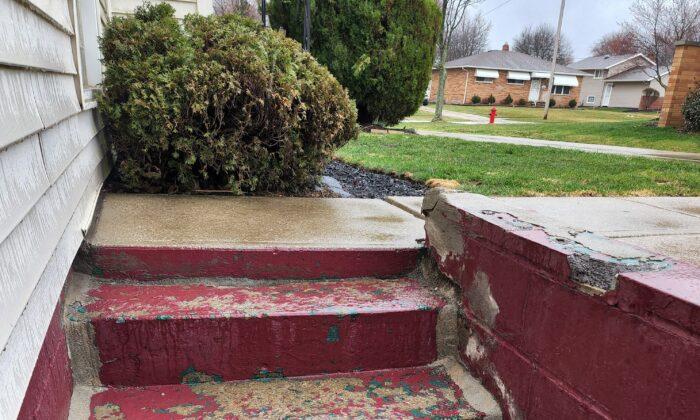Every day, I receive quite a few emails via the Ask Tim page AskTheBuilder.com. A common question, believe it or not, is how to add color to concrete. It makes sense. A lot of people dislike the drab gray color of concrete. So people ask me about painting garage floors, steps, patios and even sidewalks.
Paint, in my opinion, is not the best way to achieve the goal. First, paint can be slippery, as people typically want a shiny high-gloss finish. Something in our brains makes shiny things irresistible. This is why I think deck stain manufacturers have given us film-forming deck sealers that eventually peel.
Paints on concrete will eventually peel as well, whether the surface is indoors or outdoors. I remember as a boy helping my mom paint our basement floor. It had been painted before, but it was peeling in places. The house was built prior to World War II, and there was no vapor barrier under the concrete. The water working up through the soil under the concrete created a vapor pressure that caused the paint to fail. This is almost certain to happen to any concrete surface you decide to paint outdoors.
If you’re bound and determined to paint your concrete to add color, you can minimize the slipperiness of painted concrete by broadcasting a very fine amount of pure silica sand into the paint just after you apply it. If you hesitate even a few moments, the paint can skin over and the sand will not adhere well. You need to practice your technique to distribute the sand evenly in the paint.
Be sure you use a paint with a urethane resin. Porch paint is the best. I have a few articles at AsktheBuilder.com that go into great detail about painting porches and exactly why urethane paints are superb. You may want to check them out.
I feel the better way to add any color to existing concrete you’re trying to freshen up is to simply add a thin 1/8-inch coat of cement stucco to the concrete. You’d be stunned at how easy it is to do this and achieve professional results. What’s more, you can get really creative and use multiple colors to create distinctive patterns on your concrete. You can make an American flag with little effort, or imagine steps looking like a slanted piano keyboard.
You add color to cement stucco by blending dry-shake pigments into the mix. These pigments are readily available and come in a rainbow of colors. You can experiment and blend two different pigments to create a custom color. Concrete masons that install stamped concrete use these pigments to make their work stand out.
The cement stucco I’m talking about is just a mixture of fine sand, Portland cement, a dash of hydrated lime, and clear water. I’ve had the best success blending the cement and sand together first, and then adding the dry pigment mixing until the dry ingredients have the same color. It’s then time to add clear clean water. Your goal is to create a stucco mix that is the consistency of cool, not warm, applesauce.
It’s mission-critical for the concrete you’re going to colorize to be sound, clean, and very slightly damp. This is one of the few times I’m OK with using a pressure washer on concrete. You want to blast any old paint, mildew, mold, algae, oil, and loose, crumbling concrete away. Any of these things, if left on the surface, will interfere with the bonding of the new stucco to the old concrete.
The secret step that you rarely hear from any other home improvement guru is cement paint. I discovered this age-old secret from a very old mason when I was just starting in the business. He described how they used cement paint to ensure the cement stucco they applied to new concrete steps would stay adhered for over 100 years. He was right. Every time I visit my hometown, Cincinnati, I drive past exterior concrete steps with this stucco, and it looks as good as it did when applied in the early 1900s.
Cement paint is just what it sounds like. You mix pure Portland cement with water until it has the consistency of paint. If you’re colorizing your stucco, add some pigment to your cement paint too. You apply this with a 4-inch brush to the thickness that you’d apply normal paint. It’s vital the concrete be damp, but not wet. You must cover this paint with your stucco immediately, making sure the cement paint never dries.
The best weather in which to do this job is overcast skies with no threat of rain. An air temperature of the upper 50s F would be ideal. The worst time to do this job is on a blistering, breezy summer day. On hot, windy days, you’ll have reduced working time with the stucco, and it may dry too quickly.
Once you’ve finished rubbing the stucco with a wood or sponge-rubber float and are satisfied with the appearance, cover the work with a plastic sheet so the water can’t evaporate into the air. This will ensure the stucco will adhere really well.
I have a time-tested recipe for the stucco mix. You’d do well to mix your stucco like mine if you want it to last for 100 years! Check it out at https://GO.askthebuilder.com/MortarRecipeTip
(Subscribe to Tim’s FREE newsletter at AsktheBuilder.com. Tim now does livestreaming video M-F at 4 PM Eastern Time at youtube.com/askthebuilder.)
©2022 Tim Carter. Distributed by Tribune Content Agency, LLC.





